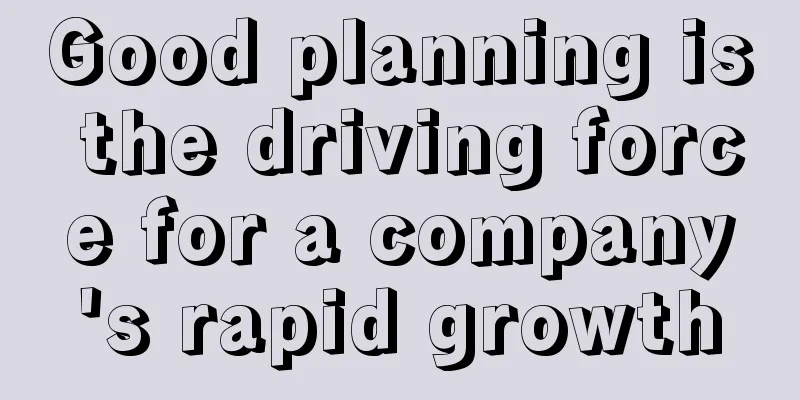Good planning is the driving force for a company's rapid growth

As a consultant for enterprises, I have in-depth contact with CEOs of many small and medium-sized companies. They are from all industries, and their revenue scale ranges from tens of millions to billions. Although I was helping them, I also learned a lot. For example, these CEOs have an extremely detailed understanding of user needs and can often provide surprising services. They don’t care so much about the so-called dividends that are gone, and have already found their place in the existing market. Another example is being extremely hardworking. I was miserable because I had to attend meetings and do research for more than ten hours every day. But in communicating with CEOs, I also found a common problem: they are not good at planning. There are several reasons:
When we talked about this, I found the problem here. Everyone assumes that planning is a rigid plan. Let me talk about my own thoughts, which are divided into the following points. 01 Planning is not a plan, it is a reflection on the businessPlans are specific execution items, which are the to-do items we list after a meeting, but planning is something on a higher level, which is your understanding and thinking about the company's business. What are cognition and thinking? Try to answer these questions:
As a CEO, how you view the business will determine different strategic directions and what you do. When Zhang Yiming was developing Toutiao, he essentially thought that it was a content product rather than a news client. This difference in positioning led to differences in content sources, distribution models, business models, and organizational structures, and ultimately changed the trend of domestic news clients. We always analyze what Toutiao does well and what it does poorly, how it differs from other news clients, and so on, but these are just specific measures, or even just inferring from the results, so there is not much point in discussing these. The key is how Zhang Yiming, as the founder, views this product, what it is essentially and how it should be defined. What does this case have to do with planning? Because thinking and making cognitive judgments are the first step and part of planning. Therefore, planning pushes or even forces CEOs to take out fixed, large blocks of time to think, rather than mindlessly investing in specific battles. In addition, after thinking, it must be implemented, so plans and programs will be formed, closing the loop from thinking to doing. 02 Planning is just a direction, constant revision and iterationThe CEO's business plan is based on current knowledge. As the business develops, knowledge will improve, and the plan will certainly change. When changes are necessary, don’t worry about other executives or employees accusing you of changing your mind every day. Many companies have "embracing change" in their culture. This is the reason. You have to adapt to competition if you want to survive. Tell a story. Zhang Wenzhong, founder of Wumart Group, holds a morning meeting every day. One day, he said that he had adjusted the structure without communicating it in advance. Some people might find it sudden, but this is what you have to accept. You should focus on what value you can bring to the table, rather than where you are, who you report to, or how high your position is. Traditional retail companies like Wumart are all pursuing efficiency and change, and other industries need to learn even more. Since things will change, why do we need to plan? Because enterprises also need directional guidance in the process of moving forward, and the specific things they do also need to be broken down by a North Star goal. Running a business is like fighting a war. You need to observe the situation, respond to the battle, and adjust your team at the same time. All elements are in a dynamic process. It is impossible to make decisions and take actions only when the conditions are determined. This is impossible. So the same goes for planning, do it, execute, revise and iterate as you go along. 03 Plan for the long term and plan for the presentPeople always say that planning requires thinking. What should we think about? Let me give you a specific question: Think about what the end game of this business is or what you think this business will look like in a year. As a CEO, you must take the time and energy to think about this issue. Only with this conclusion can you guide the current specific plans and decide what to do and what not to do. After thinking through this issue clearly and breaking it down to the execution level, the strategic plan will emerge. But don’t just have a plan. Without a specific plan, the company will float in the air, with various businesses tearing at each other, encroaching on territory, and wasting resources. What is the plan? I have 2 experiences. 1) Shorten the cycle, ranging from 1 to 3 months If the company has a plan for tens of thousands of people, a 2-3 month work plan can be accepted considering the execution cost. A specific example is ByteDance, which has been using a two-month OKR cycle for the past few years, and recently changed it to a three-month cycle, which is within the normal range. After all, the scale is large, and the external environment does not change as rapidly as a few years ago. If the company has dozens or hundreds of people, you can try to shorten it to 1-2 months. Especially for startups, business is a process of crossing the river by feeling the stones and taking one step at a time. What you do this week may guide the plan for next week, and adjustments are made frequently. In addition, the staff size is small and the organization is not complicated, so the cost of formulating and executing plans is not that high. 2) Pay attention to reviewing, which is even more important than making plans Most of our execution actions are homogeneous, or even have a fixed cycle, such as a big promotion once a month. Therefore, the cumulative value of review is exponential. The team is constantly making mistakes and optimizing. As long as the processes are well-organized and employee changes are not significant, and a good review is done, things will definitely get better and better, and the company will also accumulate methodology and knowledge structure, which is a huge asset. How to attach importance to review? As a CEO, you must pay attention to it. Only when the superiors pay attention to it, the subordinates will invest more in it. For example, leaders at all levels will spend time organizing meetings, colleagues in the data department will spend more time doing analysis, and the research and development department will do thinking and summarizing. Reviewing the past is also a matter of the company's organizational culture. Such issues must be approached from top to bottom, and the specific methods of reviewing the past are not difficult. 04 To win the battle, employees need confidence and enthusiasmThere are fast-growing companies in every stage, such as BAT more than a decade ago and TMD later. You will find that these companies are constantly winning battles, top talents are constantly joining, and employee morale is also very high. Win the battle → Excellent talents join → Employee morale is high → The company develops rapidly → Win the battle... From a certain logic, this is a positive cycle, which is what we all want to see. Otherwise, it is a negative cycle. I have visited different companies, and to be honest, just by walking around the work area, I can feel whether it is a positive cycle or a negative cycle. This feeling also matches the current situation of the company. Therefore, as a CEO, you must lead the company and employees to victory and promote this positive cycle. Is it difficult to win a battle? Of course it is. But as a CEO, playing this game is advantageous because you can set the rules of the game. For example, which battle to fight, how to judge the victory or defeat, how to manage the process, and how to reward or punish the results. When I was at a startup, I developed a similar "battle." Before the implementation, we can be sure that as long as we keep working hard for a month, we will definitely get good results and usher in a victory. So we constantly do detailed management in the process, frequently communicate and encourage the team, do weekly summaries and reviews, and finally give everyone a satisfactory reward. After winning this "battle", the team is more cohesive and has more confidence in the company, business, and boss. There is also theoretical support for protecting employee confidence and enthusiasm. In the book "Fogg Behavior Model", the core idea is B=MAP. But hidden under this idea, the author BJ Fogg repeatedly emphasizes the role of subjective initiative. For example, don’t think that you are not capable enough, but that your method is wrong; you should lower the threshold for doing things, break down the steps, etc., all of which are cautious ways to protect your enthusiasm. Because maintaining confidence and enthusiasm is the prerequisite for getting things done. The above is my feeling in daily consulting work. I hope it will be helpful to you. Author: Han Xu Source: WeChat public account "Operation Dog Work Diary (ID: yunyingriji)" |
<<: This is the best user growth analysis model I have ever seen
>>: I no longer believe in buying traffic from outside, but can I count on the video account?
Recommend
How to break through the conversion bottleneck of online education through operation, you must understand this method
Conversion rate is like a curse on every online ed...
Can Heytea, which has won a great success through its collaboration with FENDI, return to its “peak”?
One of the most popular events in the tea industry...
Can I use Bank of China to pay for items purchased on Amazon Japan? How can I pay?
Amazon Japan now has a direct mail service to Chin...
Can one person start Amazon? What are the conditions?
When people choose to do cross-border e-commerce o...
Where can I view Amazon's deduction details? How can I cancel Amazon's automatic deductions?
When we open a store on Amazon, if we want to unde...
What sites does eBay have? Which eBay site is good for business?
As a member of the cross-border e-commerce platfor...
How many days does Amazon Black Friday and Cyber Monday last? What are the rules?
Amazon is a cross-border e-commerce platform, but ...
[User Growth] Channel Growth SOP: Easily implement internal channel efficiency review and analysis
WeChat is an important internal channel distributi...
Branding techniques: three routes, upper, middle and lower, 9 techniques
Every position has its necessary professional foun...
Zibo barbecue brings popularity to the "Shandong Tour" during the May Day holiday
Introduction: The May Day tourism season is approa...
How to cancel Amazon membership automatic renewal? Steps
Now many friends have started to use the Amazon pl...
20 trends and thoughtful suggestions for brands in 2023
2023, the new year's brand forecast is here! T...
Xiaohongshu e-commerce: Chaos in expansion
This article introduces the current status of Xiao...
What does it mean when a cross-border e-commerce order is closed? What is the difference between an order being canceled and closed?
In cross-border e-commerce, sellers and buyers oft...
From seeding to conversion, how can brand merchants make e-commerce gold from social media platforms?
A commercial consensus has gradually been reached ...

![Data analysis report, how to write the [Suggestions] section?](/upload/images/67e7486882b52.webp)







